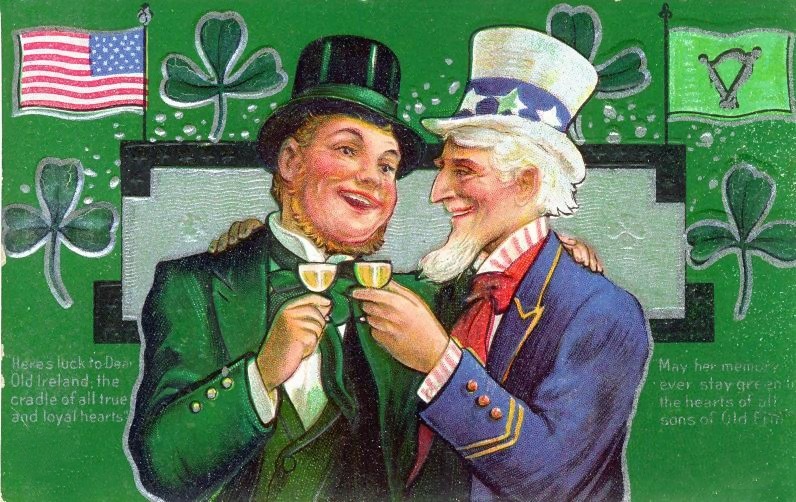Irish American Heritage Museum
Posted by Jim on July 5, 2020

A quick post about some of the Irish Americans who contributed to this nation, and who are featured in our new exhibition here at the Musuem.
The first American general to die in battle was Irish:
Dublin-native Richard Montgomery is the first general to have been killed in battle during the American Revolutionary War. Montgomery was killed in the Battle of Quebec during the 1775 invasion of Canada.
Three of the signers of the Declaration of Independence were born in Ireland:
Three of the eight foreign-born men were natives of Ireland. These Irish patriots of the American Revolution are James Smith, from Northern Ireland; George Taylor, an Irish native and a member of the Committee of Correspondence; and Matthew Thornton, an Irishman who became a member of the Continental Congress in 1776.
An Irishman designed the White House:
Irishman James Hoban designed the White House, modeled after an Irish building. The presidential residence is officially twinned with Dublin’s Leinster House.
An Irishman wrote the melody for the Star Spangled Banner:
In 1913, on the song’s hundredth anniversary, a scholarly commission was formed to determine conclusively the song’s origins. It finally came to the conclusion that the music most probably originated in Ireland. While the original melody was a London drinking song called “Anacreon in Heaven,” created by John Stafford Smith in 1793, Smith never claimed authorship of the music. Experts on the commission narrowed the anthem’s origins to one of two possible Irish musicians who lived during the 18th century. The first was William McKeague from County Fermanagh, who some believed composed it as the regimental song for the Royal Inniskillin Fusiliers. However, the more likely writer of the famous melody is the greatest composer Ireland ever had – Turlough O’Carolan, the last of the Irish bards. The O’Carolan song regarded as the “ancestor” of the national anthem is his 1723 tune “Bumper Squire Jones,” is in fact metrically identical to Key’s famous song!
1775-1781: The Revolutionary War
It is estimated that one-third to one-half of George Washington’s army were Irish born or first-generation, including 1,492 officers and 26 generals, 15 of whom were Irish natives, chief among them Commodore John Barry. Washington is quoted as saying: “When our friendless standards were first unfurled, who were the strangers who first mustered around our staff, and when it reeled in the light, who more brilliantly sustained it than Erin’s generous sons. Ireland, thou friend of my country in my country’s most friendless days, much injured, much enduring land, accept this poor tribute from one who esteems thy worth, and mourns thy desolation. May the God of Heaven, in His justice and mercy, grant thee more prosperous fortunes, and in His own time, cause the sun of Freedom to shed its benign radiance on the Emerald Isle.”
An Irishman is the “father” of the Navy:
John Barry, a native of Co Wexford, is known as the “Father of the American Navy.” He and his crew fought and won the final naval battle.
1879: Unions
In 1879, Terence Powderly, a son of Irish immigrants, was elected head of the Knights of Labor, a national association of labor unions. Under his stewardship, the association grew to include more than 700,000 members. Mother Jones, Mary Harris from Cork, toured the country, advocating for workers’ rights – she was called “The Most Dangerous Woman in America.” With the increase in numbers, the unions were better able to facilitate strikes and dramatically improve working conditions for U.S. laborers. At the turn of the twentieth century, Sam Gompers and P.J. McGuire, a second-generation Irish-American, co-founded the American Federation of Labor (AFL). By 1910, nearly half the AFL’s 110 member unions were led by Irish-born or Irish-American men. In 1920, union membership rose to new heights, reaching five million nationwide. In 1955, George Meany, who began as a plumber’s apprentice, became the first head of the merged American Federation of Labor — Congress of Industrial Workers (AFL-CIO), the nation’s largest labor organization. In 1995, John Sweeney, a second-generation Irish-American, was elected president, serving 5 terms.
And of course, millions of anonymous Irish came to this country, fleeing famine, poverty, prejudice, seeking opportunity, and worked with others to build the canals, railways, and cities of their new home. They worked hard, passed on their heritage and culture to their children, and were proud to be Americans.
Happy Independence Day to everyone, especially all the people who come to America seeking a better life.